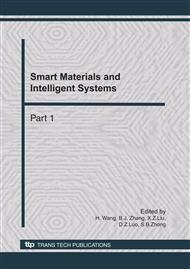[1]
D.D. L Chung: Self-monitoring structural materials. Materials Science and Engineering, Vol. 22 (1998), pp.57-58.
Google Scholar
[2]
WANG S, SHUI X, FU X: Early fatigue damage in carbon-fiber composites observed by electrical resistance measurement. Journal of Materials Science, Vol. 33 (1998), pp.3875-3884.
Google Scholar
[3]
Fu.X. L, D.D.L. Chung: Improving the strain-sensing ability of carbon fiber-reinforced cement by ozone treatment of the fibers. Cement and Concrete Research, Vol. 28 (1998), pp.183-187.
DOI: 10.1016/s0008-8846(97)00265-2
Google Scholar
[4]
X. Fu, D.D.L. Chung: Self-monitoring of fatigue damage in carbon fiber reinforced cement. Cement and Concrete Research, Vol. 26 (1996), pp.15-20.
DOI: 10.1016/0008-8846(95)00184-0
Google Scholar
[5]
GUAN Xin-chun, OU Jin-ping, HAN Bao-guo, BA Heng-jing: State of art of carbon fiber reinforced concrete. Journal of Harbin University of C. E. & Architecture, Vol. 35 (2002), pp.55-59.
Google Scholar
[6]
HAN Baoguo, GUAN Xinchun, OU Jinping: Correlation between shape of electric admixtures and piezoresistive effect of cement based composite materials. Acta materiae compositae sinica, Vol. 21 (2004), pp.137-141.
Google Scholar
[7]
FAN Xiao-ming, DONG Xu, SUN Ming-qing, LI Zhuo-qiu: Research on the electric characteristic and pressure sensitivity of graphite-cement based composites. Journal of Wuhan university of technology, Vol. 31 (2009), pp.12-14.
Google Scholar
[8]
P. Kumar Mehta, Paulo J.M. Monteiro: Concrete: Microstructure, Properties, and Materials. (China Electric Power Press, Beijing 2008).
Google Scholar
[9]
Han Baoguo, Guan Xinchun, Ou JinPing: Study of test method for resistance of carbon fiber reinforced cement. Fiber reinforced plastics/composites, Vol. 11 (2003), pp.6-8, 59.
Google Scholar
[10]
Mao Qizhao, Sun Mingqing, Chen Pinhua: Study on Volume Resistance and Surface Resistance of CFRC. Journal of WuHan university of technology. Vol. 19 (1997), pp.65-67.
Google Scholar
[11]
YI Cheng, FAN Yong-kui, ZHUHong-guang, ZHUXu-pin: Characterization Study on Fatigue Life of Concrete under Uniaxial Compression. Journal of building materials. Vol. 11 (2008), pp.132-137.
Google Scholar


